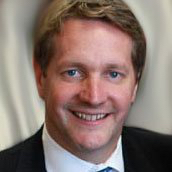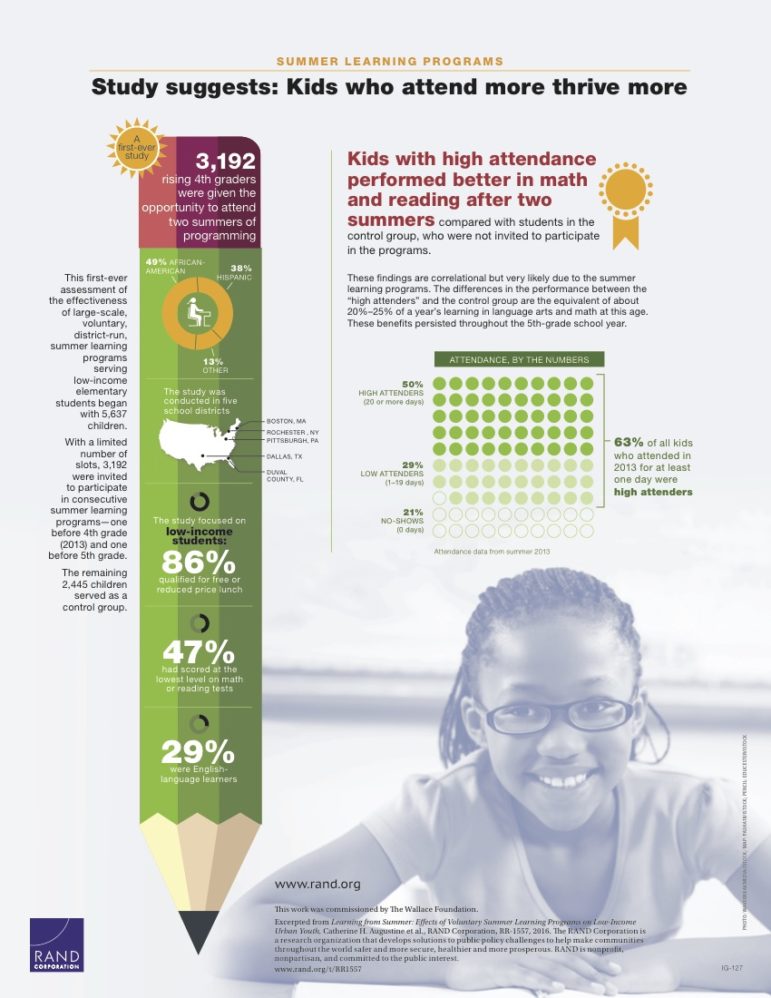
Students who regularly attended summer learning programs experienced lasting increases in mathematics and language arts abilities, as well as an increase in social and emotional competency, according to the report “Learning From Summer — Effects of Voluntary Summer Learning Programs on Low-Income Urban Youth,” released Wednesday by The Wallace Foundation.
“Our study clearly shows the benefits for the students who had high attendance rates or high amounts of academic instruction in the summer learning programs,” said Catherine H. Augustine, the study’s lead author and senior policy researcher at The RAND Corporation, a nonprofit research organization. “To help as many students as possible reap these benefits, the study suggests that districts run summer programs for at least five weeks, include sufficient time on academics and focus on the challenge of achieving high attendance rates.”
According to the report, research indicates low-income students learn less in a year than those from wealthier families do. This is partially attributed to the summer learning gap: Children from poor families are less likely to participate in sports and education activities during summer vacation. The $50 million National Summer Learning Project was conducted with the overall goal of bridging this divide between students of different economic backgrounds.
Sponsored by The Wallace Foundation, RAND began the study in 2013 with 3,000 students who were entering the fourth grade in five urban school districts — Boston; Dallas; Duval County, Florida; Pittsburgh, and Rochester, New York. The research aimed to measure the effects of free public school summer learning programs on achievement in math and language arts, as well as social, emotional and behavioral effects. The report details the progress of the same students from the summer of 2013 to the spring of 2015; the research is set to continue until the spring 2017.
“Until now, we didn’t know if urban school districts could offer high-quality summer learning programs for low-income students and whether they would make a difference for children,” Will Miller, president of The Wallace Foundation, said in a press release. “We have learned two important things: That high-quality summer learning programs are capable of helping disadvantaged students succeed in school, and that high attendance is crucial to delivering these benefits.”
In all five cities, school districts partnered with community-based organizations, including jointly designing and managing the summer programs in Boston and Dallas.
“It’s exciting that so many different kinds of programs can play a meaningful role

Chris Smith, executive director of Boston After School & Beyond
in summer learning and that their combined efforts can produce results not just during the summer but throughout the school year,” said Chris Smith, executive director of Boston After School & Beyond, which worked with the district there on the program.
The study’s findings on attendance are especially encouraging, because program providers know they can improve how consistently students show up, he said.
Seven Boston program providers were part of the study, but a larger network of 100 out-of-school-time providers has been working for several years to build the city’s summer programming infrastructure. The results point the way for all those groups, Smith said.
Key takeaways from Boston providers’ experiences Smith noted include that providers should:
- play to their strengths by offering enrichment programming in their areas of expertise;
- measure performance; and
- plan throughout the school year alongside their peers and the district to ensure the best outcomes for students.
“Programs that are open to collaborating with each other will strengthen their hand when they’re trying to work with the school district, rather than forming separate individual relationships,” Smith said.
The study required the participating school districts to offer voluntary classes five days per week for five weeks in the summer, with at least three hours of instruction per day, in class sizes of no more than 15 students per adult. Free student transportation and meals were also required.
Students were randomly separated into two groups. Those in one group participated in a summer learning project. Those in the other did not, though they were allowed to enroll in other summer programs not involved with the study.
Decreased attendance greatly affected the summer programs’ impact. Program attendance drastically decreased in summer 2014. Almost 50 percent of enrolled students did not participate in the program in 2014, while 21 percent of enrolled students didn’t attend in 2013. Of those who participated one day or more, students attended 75 percent of the time in 2013 and 2014.

The Wallace Foundation/RAND
Summer learning programs study shows who attend more thrive more. The new report is available for download at wallacefoundation.org.
During summer 2013, researchers found a slight yet statistically significant increase in mathematical abilities in students enrolled in the summer learning programs. These improvements didn’t last over time because of the increasing number of students with poor attendance. The results do show positive effects in language arts and other subjects, but the improvements were not statistically significant.
However, students who attended 20 or more days during the first summer experienced a significant increase in mathematical abilities, which they retained into spring 2014. During the summer programs, the students with good attendance improved their math abilities by 25 percent more than the average student is expected to learn during a school year.
After the summer programs of 2014, students who attended 20 days or more experienced increases in their social and emotional competency, as well as lasting benefits to mathematics and language arts abilities.
Other school districts can get similar results by offering voluntary, free programs to low-income late elementary students in urban settings, the report says. Its tips include improving teaching techniques and budgeting based on expected attendance.
Sarah Barr contributed to this story.



























